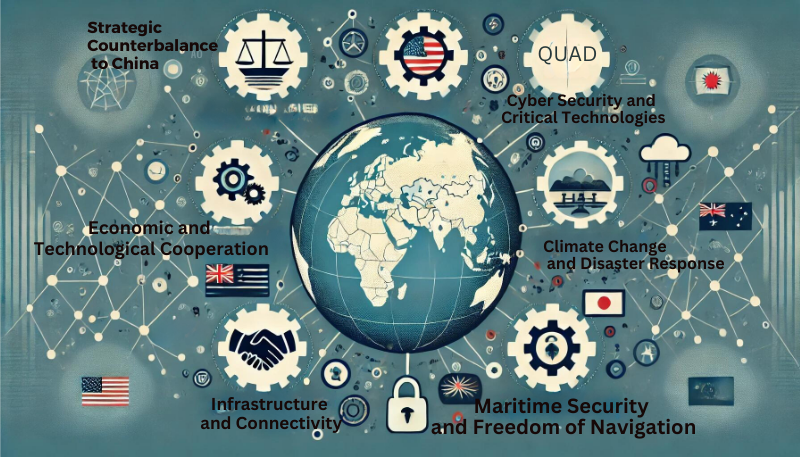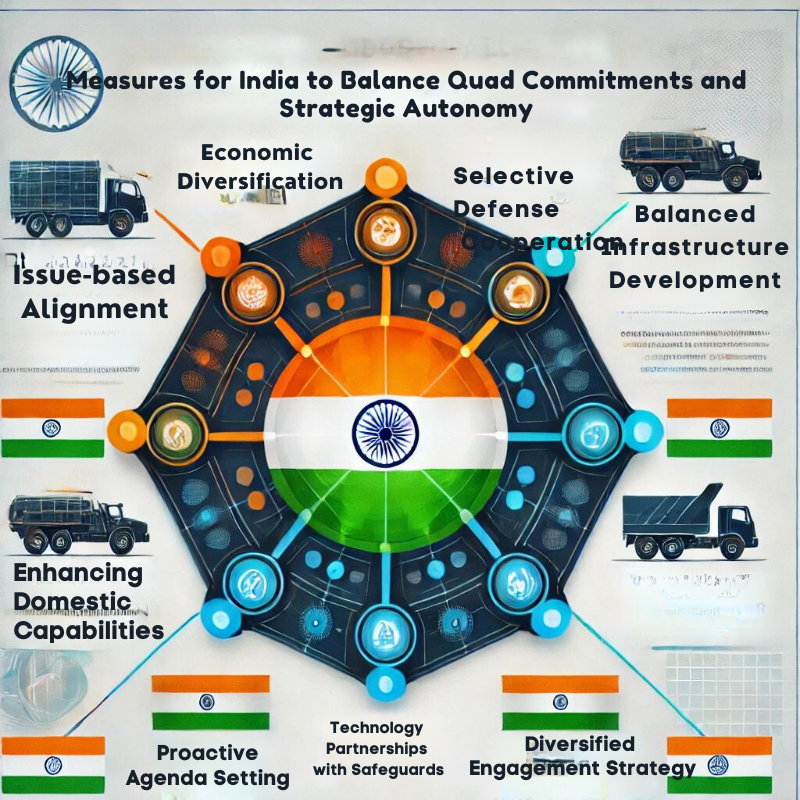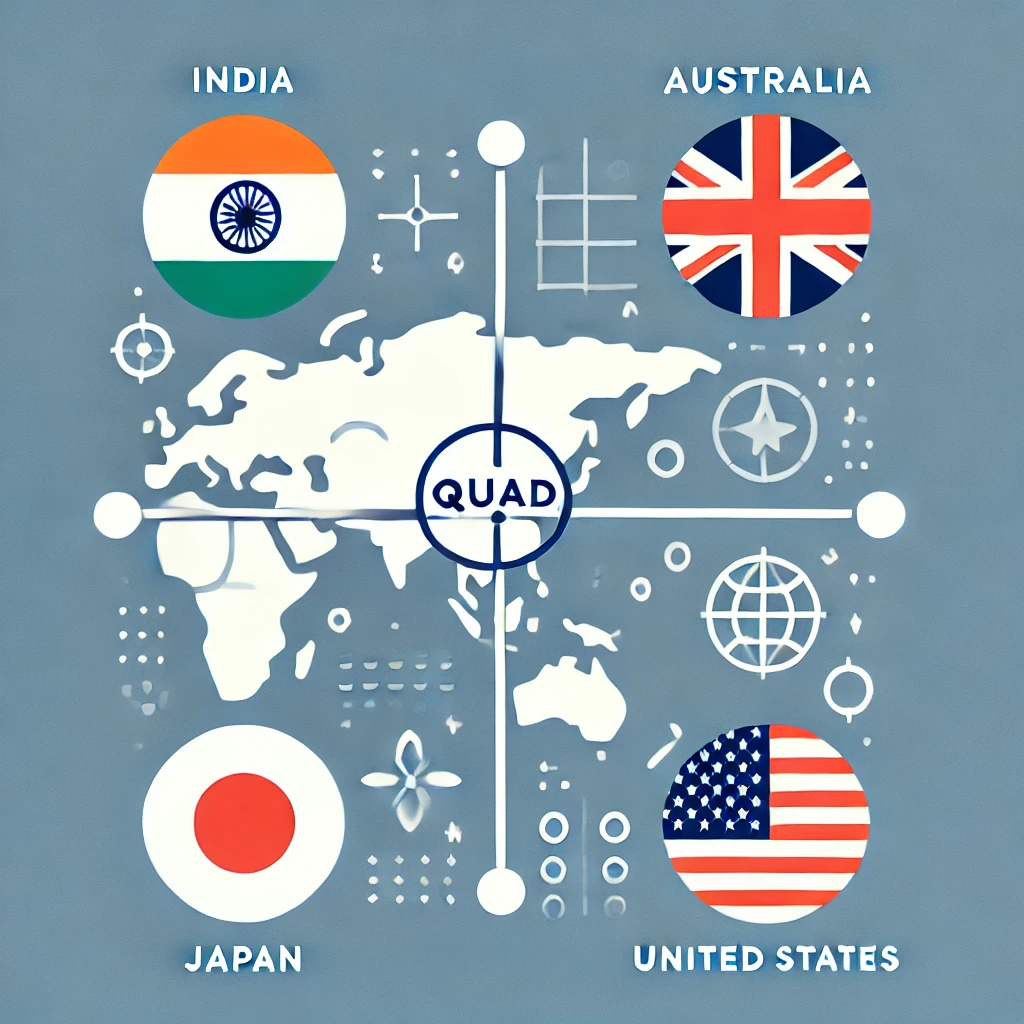QUAD or Quadrilateral Security Dialogue is an informal alliance consisting of India, Australia, Japan, and the United States. This group aims to help foster a free, open, and prosperous region in the Indo-Pacific. Recently, the Quad diversified its focus from mere security to healthcare, cybersecurity, and infrastructure. Diversification helps the Quad not look like “Asian NATO” and gain acceptance among ASEAN nations. For India, the Quad provides an informal platform to counter China’s increasing ascendancy without formal military alliances, quite in sync with the Indian diplomatic approach.
| GS Paper | GS Paper III |
| Topics for UPSC Prelims | Quadrilateral Security Dialogue, ASEAN nations, Malabar series, National Quantum Mission, Quad Critical & Emerging Technology Forum, Indo-Pacific Economic Framework, International North-South Transport Corridor, Coalition for Disaster Resilient Infrastructure, Open Radio Access Networks , Russia’s invasion of Ukraine, India’s use of Russian S-400 missile systems. |
| Topics for UPSC Mains | Significance of QUAD for India, Major Challenges Related to QUAD for India. |
Origin of the Article
This editorial is based on “The Quad’s agenda may seem small, but its achievements are not,” published in The Indian Express published 23/09/2024. The article elaborates on how the Quad has evolved into an all-embracing forum to give India space for regional cooperation without sacrificing strategic autonomy.
Relevance for UPSC Students
The understanding of international relations and India’s foreign policy stands incomplete without the mention of the Quad. Knowledge about the Quad, therefore, shall aid a candidate in GS Paper 2 under Groupings & Agreements Involving India and Affecting India’s Interests. Strategic, economic, and technological cooperation form crucial knowledge elements for both Prelims as well as Mains.
Why in News?
Recently, The Quad has become a popular name due to the new geopolitical conditions relating to its transforming role in the regional cooperation and strategic balancing of the Indo-Pacific region. Therefore, what exactly is a multiplex agenda of the Quad, whether it is in the domains of initiatives under the health agenda or developing cyber security along with infrastructure, is an essential understanding of the issue for UPSC aspirants because it provides the context for India’s strategic autonomy countering China’s assertiveness. It is, therefore, a very relevant topic area since questions regarding international groupings and the diplomacy of India have been asked in UPSC examinations in the past.
What is QUAD?
The Quad, or Quadrilateral Security Dialogue, is an informal diplomatic alliance between four countries: Australia, India, Japan, and the United States. This alliance promotes an open, stable, and prosperous Indo-Pacific region. It was originally proposed by Japanese Prime Minister Shinzo Abe back in 2007 but finally became a formal group in 2017, rising above the previously experienced obstructions, such as Australia’s earlier withdrawal under Chinese pressure.
Historical Background
It was in 2007 when Japanese Prime Minister Shinzo Abe conceptualized the idea of Quad intending to form a strategic alliance to provide much-needed strength to regional security. Plans had their setbacks, with Australia being the one to back out fearing pressure from China. Officially revived in 2017, after this date, there was seriousness among all the members to pool their strengths against common challenges in the Indo-Pacific region.

What does QUAD mean for India?
The Quad holds immense strategic, economic, and technological importance for India. For India, it enhances regional connectivity, maritime security, climate action, and cybersecurity in alignment with broader strategic interests and offers a platform for multifaceted cooperation.
Strategic Counterbalance to China
The Quad gives India the strategic balance against China’s increasing intransigence in the Indo-Pacific. For example, these tensions on the border persist, at least as the Galwan Valley clashes of 2020-2021 depicts. The joint naval exercises like the Malabar series which it hosts especially focus on the advanced anti-submarine warfare drills as part of 2023 Malabar, address head-on concerns relating to China’s growing submarine fleet.
Economic and Technological Cooperation
The Quad provides India with access to advanced technologies and economic partnerships. The Quad Critical & Emerging Technology Forum has focused on AI, quantum computing, and biotechnology by supporting the National Quantum Mission for India. Initiatives like IPEF, developed in 2022, would hence offer alternative frameworks beyond China-centric economic arrangements.
Infrastructure and Connectivity
Regional connectivity initiatives by India are also shared with Quad infrastructure initiatives. Complementing other group efforts such as INSTC, designed to counterbalance China’s “String of Pearls,” is India’s strategy of “Diamond of Necklace.”
Maritime Security and Freedom of Navigation
The Quad is also a demonstration of India’s commitment to free and open sea lanes in the Indo-Pacific, which are vital for trade and energy security. Another aspect of the new cooperation framework has been the launch of the Indo-Pacific Maritime Domain Awareness (IPMDA) partnership in 2022, which enhances maritime security by providing near-real-time information to prevent illegal activities, such as piracy in the Arabian Sea.
Climate Change and Disaster Response
It focuses on climate change and disaster response, two fields very important for India. The Q-CHAMP: the Quad Climate Change Adaptation and Mitigation Package launched in 2022 foci solely on green shipping corridors and clean energy cooperation. That meshes with its renewable energy targets and supplements a leadership position in initiatives such as the Coalition for Disaster Resilient Infrastructure.
Cyber Security and Critical Technologies
The Quad framework further enhances the cybersecurity and critical technologies of India. The Quad Cybersecurity Partnership, announced in 2023, is to enhance cyber resilience. In 2022, over 1.39 million cybersecurity incidents hit India. Cooperative activities such as deployment in the area of 5G and semiconductor supply chains further fortify India’s technological sovereignty.
Primary Challenges of QUAD for India
The Quad framework still poses several challenges for India to balance out – relations with China, divergent priorities among Quad members, resource constraints, perceived economic costs, regional perceptions, and interoperability issues.
The Balancing Act with China
Balancing the participation of India in the Quad with a fragile relationship with China will be an arduous act. Even though the Quad asserted it is not anti-China, Beijing sees it as a containment strategy, which complicates relations that India wants to manage between the two countries, since border tensions persist and economic interdependence is significant.
Divergent Priorities within QUAD
The general priorities of the Quad members do not tend to align. While the US and Australia may focus on more security-oriented agenda items, India would like to have a wider approach. Such differences in approach towards issues such as Russia’s invasion of Ukraine could very well damage the effectiveness of Quad initiatives from an Indian point of view.
Resource and Capacity Constraints
Quad initiatives are the ones that can only be implemented with huge resources and that might be challenging for India. For instance, in the case of the COVID-19 Vaccine Partnership of Quad, it was ready to tap into the manufacturing capability of India, but attempting to fill the huge domestic demand for vaccines became a hard nut to crack. Investment in critical and emerging technologies requires much more finance and manpower.
Economic Cost Opportunity
Quad steps toward an effort at reducing dependence on China would therefore entail short-term economic costs for India. The exercise of diversified supply chains away from China, for example, in electronics is a high-investment and time-consuming exercise that could have negative impacts on growth.
Regional Perceptions and Diplomatic Challenges
India needs to manage regional perception on the Quad, especially with ASEAN nations, so it is not diplomatically isolated. Some states within ASEAN think that the Quad may isolate ASEAN centrality. It adds diplomatic complexity if participation in the Quad is balanced with engagement within other regional groupings like BRICS.
Operational and Interoperability Challenges
Apart from the functional difficulties, interoperability with other QUAD members would raise operational challenges to India. The diverse military equipment-on-board, many of them of Russian origin, will cause operational trouble. This is an operational challenge that the relations between India and the Russian S-400 missile system throw in its way, of US sanctions through the CAATSA act, complicating defense cooperation within the QUAD.

What can India do to balance its QUAD commitments without sacrificing strategic autonomy?
India can balance its QUAD commitment with its identity of strategic autonomy through issue-based alignment, enhancing domestic capabilities, proactive agenda setting, diversified engagement, balanced infrastructure development, selective defense cooperation, economic diversification, and technology partnerships with safeguards.
Issue-Based Alignment within QUAD
It requires India to strengthen its domestic capabilities in order to balance QUAD commitments with strategic autonomy. It can actively participate within the QUAD alliance but has every right to reserve independent decision-making capabilities through investment in economic growth, technological advancements, and modernization of the military. This strategy will ensure the preservation of national interests along with international partnerships.
Raise Domestic Capabilities
India has to build its domestic capabilities and complement its QUAD commitments as this balancing requirement calls for an appropriate articulation of strategic autonomy. Adopting this partnership, India must spend significant resources on advanced defense technology, improve economic resilience, enhance the scope for innovation, and look to strengthen the institutional frameworks to be a part of the Quad Alliance without sacrificing independent policy stances or making national interests secondary.
Policymaking Well Ahead
India must take the lead on the Quad agenda and focus on areas where it has comparative advantage. This means India’s engagement with ISA will actually shape the climate agenda of Quad, in league with its renewable energy priorities.
Diversified Engagement Strategy
India needs to engage multiple regional and global forums along with the Quad. It must be proactively engaged with BRICS, SCO, and ASEAN-led mechanisms so that no particular grouping forms a stranglehold, and diplomacy and strategic engagements remain well-balanced.
Infrastructure Development in Balance
Projects under the sovereign projects area, leveraging infrastructure initiatives under Quad. Investments can be attracted into Indian projects without compromising on the ‘control’ issue as seen in the development of the Colombo West Container Terminal with Japan.
Selective Defense Cooperation
Under the summit, India must remain selective in its military entanglement. It must concentrate on interoperability and capacity building measures without entering binding defense pacts that would interfere with its strategic autonomy, as is well illustrated by its reciprocal support agreement with the United States.
Economic Diversification
There is a need to activate the summit in terms of economic partnerships that are able to move diversified sovereignty without harming it. SCRI and the IPEF reduce dependence on China without clear targeting of countries.
Technology Partnerships with Safeguards
Safe technology transfers with reasonable safeguards protecting data, are guaranteed through summit technologies. Efforts of the Personal Data Protection Act 2024 by India towards indigenous 5G technology find expression with quad in the context of its goals for safe telecommunication along with technological sovereignty.
PESTEL Analysis
| Political: The Quad provides India with a strategic alliance to counterbalance China’s influence in the Indo-Pacific. Joint naval exercises enhance maritime capabilities while differing member priorities and regional diplomatic sensitivities challenge cohesion and effectiveness within the alliance. Economic: Participation in the Quad grants India access to advanced technologies and robust economic partnerships, supporting initiatives like the National Quantum Mission. However, shifting supply chains from China may cause short-term disruptions, necessitating significant investments for long-term economic diversification. Social: Quad initiatives enhance regional connectivity and socio-economic development through projects like the International North-South Transport Corridor. Collaborative cybersecurity efforts improve public trust, while joint climate and disaster response initiatives align with India’s renewable energy and resilience goals, benefiting society. Technological: The Quad facilitates access to cutting-edge technologies in AI, quantum computing, and biotechnology, fostering India’s innovation and self-reliance. Cybersecurity partnerships strengthen technological infrastructure, though interoperability challenges, such as integrating diverse defense systems, remain a concern for seamless collaboration. Environmental: Quad collaboration supports India’s climate initiatives through programs like Q-CHAMP, promoting renewable energy and sustainable development. Maritime security efforts help protect marine ecosystems by ensuring free sea lanes and combating illegal fishing, aligning with India’s commitment to environmental sustainability. Legal: India’s involvement in the Quad requires adherence to the Personal Data Protection Act 2024 for secure data sharing and compliance with international laws for infrastructure projects. Defense cooperation must align with national procurement laws, ensuring strategic autonomy while engaging in multilateral defense initiatives. |
Conclusion
Engagement with the Quad will provide India with a strategic platform for regional cooperation and China counterbalancing, while it can remain strategically autonomous. Here, India can effectively maneuver its geopolitical interests by pursuing issue-based alignment, upgrading domestic capabilities, and proactively shaping the agenda of the Quad. Diversified partnerships and selective cooperation will thus protect India’s sovereignty while benefits from the initiatives of the Quad accrue to it.
| UPSC Civil Services Examination, Previous Year Questions (PYQs) Mains Q. Discuss the role of the Quad in strengthening relations between India and other countries in the Indo-Pacific region. (2022, GS Paper-II) Q. Discuss the strategic significance of the Quadrilateral Security Dialogue (Quad) for India in balancing its relations with the US and China in the Indo-Pacific region. |

